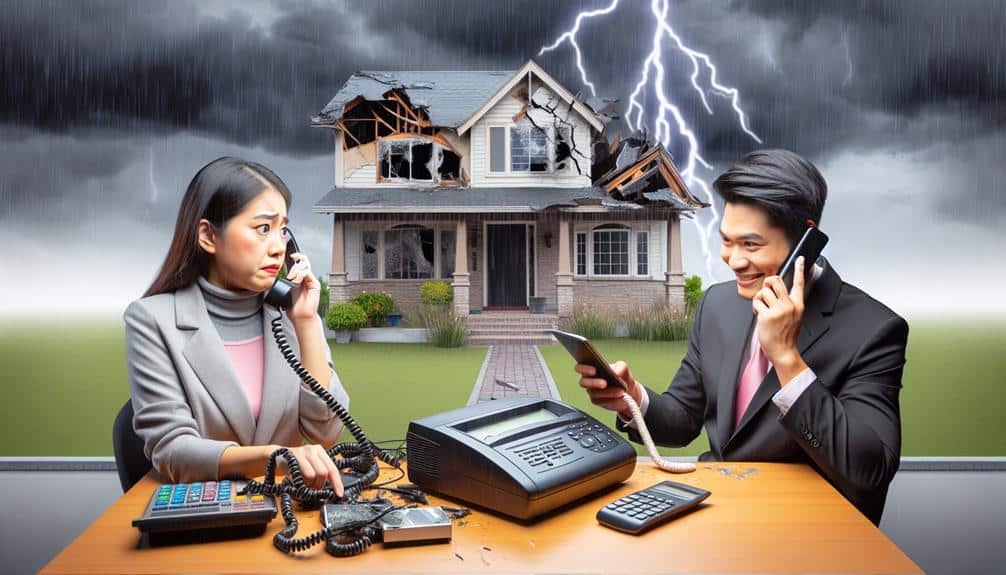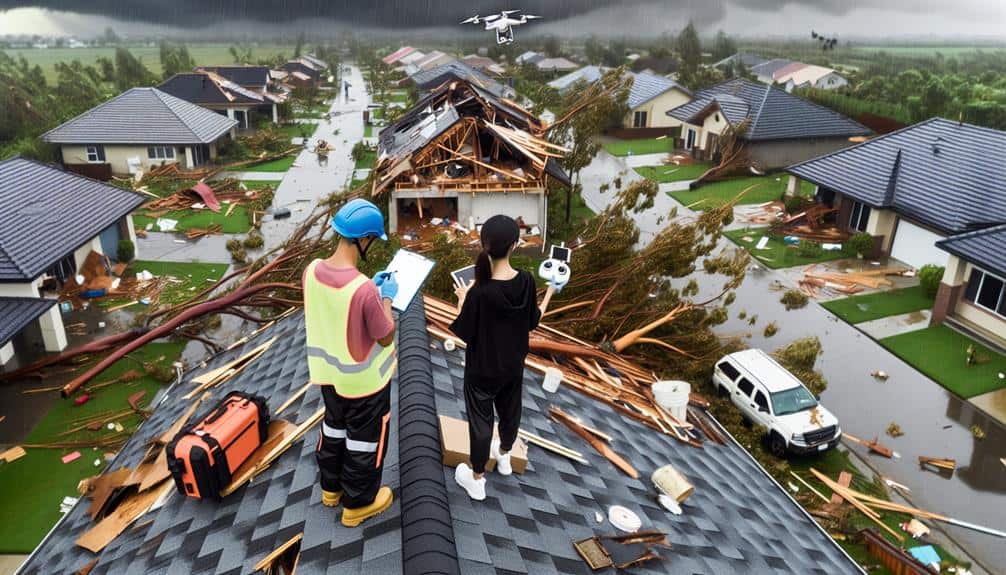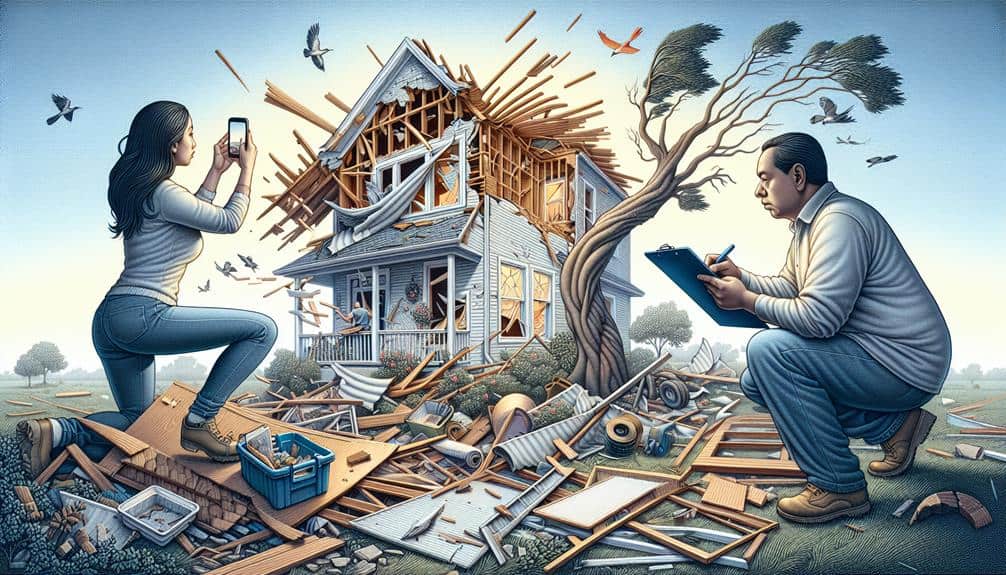When documenting lightning damage, we need to prioritize safety by checking for downed power lines and severe threats while inspecting the property thoroughly. We should take high-quality, timestamped photos capturing both wide-angle and detailed views of the damage. It's crucial to consider weather conditions during the strike, documenting the time, duration, and intensity, supported by meteorological reports. Gathering witness statements can provide additional context and validate weather records. To wrap up, contacting our insurance provider with all collected information will help us understand the coverage and claim process better. For further insights and detailed steps, continue exploring the topic with us.
Key Points
- Assess the immediate area for safety hazards and downed power lines before documentation.
- Capture high-quality, timestamped photos of both wide-angle and detailed views of the damage.
- Note weather conditions during the strike, including time, duration, and storm intensity.
- Record witness statements to gain additional context and validate weather data.
Assess the Immediate Area
Before documenting lightning damage, we must first assess the immediate area for safety hazards and visible signs of impact. Our primary concern is ensuring that the site is secure before any further steps are taken. We should start by implementing safety precautions, such as wearing protective gear and ensuring the area is free of downed power lines or other immediate dangers. If we identify any severe safety threats, it's vital to contact emergency services right away.
Next, we must conduct a thorough property inspection to evaluate the extent of the damage. This involves checking both the exterior and interior of the structure for any signs of impact. We should pay close attention to the structural integrity of the building, looking for cracks, burns, or weakened sections that could pose a danger.
It's also essential to inspect the roof, walls, and foundation, as lightning strikes can cause hidden but significant damage.
Photograph All Damage
Once we've confirmed the area is safe and thoroughly inspected for structural damage, we should begin photographing all visible signs of lightning impact. This step is vital for a detailed damage assessment and effective evidence collection. By capturing high-quality images, we provide a visual record that can validate the extent of the damage for insurance claims or repair estimates.
Let's focus on photographing various aspects of the damage. Start with wide-angle shots to capture the overall scene, documenting the broader impact on the property. Then, move closer to take detailed pictures of specific damage, such as charred areas, burn marks, or shattered windows. Make sure to photograph any damaged electronics, appliances, or other personal property affected by the lightning strike.
We should also document any indirect damage caused by the lightning, like water intrusion from compromised roofs or walls. Taking photos from multiple angles and distances ensures a thorough portrayal of the damage. Using a timestamp feature on the camera can add another layer of precision to our evidence collection.
Ultimately, meticulously photographing all lightning damage supports a clear, objective damage assessment, empowering us to seek appropriate remedies and maintain our flexibility in handling the aftermath.
Note Weather Conditions
Understanding the weather conditions at the time of the lightning strike is crucial for a thorough damage evaluation. Knowing the specifics of the weather can help us establish a clear timeline and context for the incident. Did the storm involve heavy rainfall, strong gusts, or rapid temperature changes? These elements may impact the extent and type of damage caused. Additionally, documenting the precise time, duration, and intensity of the storm provides valuable data for insurance claims and repairs.
We should also pay close attention to lightning patterns. By analyzing these patterns, we can determine if the strike was an isolated occurrence or part of a larger storm system. This information can guide us in evaluating potential risks to other structures and systems in the area. Lightning patterns can reveal the frequency and distribution of strikes, helping us understand the likelihood of future incidents.
Meteorological reports and radar data are essential tools in this process. They offer detailed insights into the storm's characteristics, which can be cross-referenced with the damage observed on-site.
Record Witness Statements
After meticulously documenting the weather conditions and lightning patterns, we turn our attention to recording witness statements to gain a thorough understanding of the incident. Interviewing witnesses isn't just about gathering evidence; it's about piecing together the narrative that supports our documentation. We need to approach each witness with professionalism and sensitivity, making sure their accounts are accurate and detailed.
When we interview witnesses, we should focus on the following:
- Uncovering vital details: Witnesses might offer insights we hadn't considered, like the exact time of the lightning strike or any preceding unusual events.
- Validating weather records: Personal accounts can reinforce or challenge our documented weather conditions, adding another layer of reliability.
As we gather evidence, it's crucial to ask open-ended questions that allow witnesses to share their experiences freely. This approach not only respects their perspectives but also guarantees we capture the most accurate and detailed information possible.
Contact Insurance Provider

It's crucial we contact our insurance provider promptly to report the lightning damage and kickstart the claims process. First, we should review our policy coverage to understand what's included and any specific requirements for filing a claim. This will help us gather the necessary information and documentation efficiently.
When we call the insurance company, we need to provide detailed information about the incident, including the date and time of the lightning strike, the extent of the damage, and any immediate actions taken to mitigate further harm. Clear communication is key to making sure that the insurance adjuster fully understands the situation.
We should ask for a thorough explanation of the claim process. This includes understanding the timeline for inspections, any forms we need to complete, and the procedure for submitting evidence such as photos, videos, and witness statements. Knowing these steps helps us stay organized and meet all deadlines.
Additionally, we must inquire about any out-of-pocket expenses we might incur and the possibility of reimbursement. Understanding our policy coverage and the claim process ensures we navigate this challenging time with confidence and efficiency, ultimately restoring our property and peace of mind.
Frequently Asked Questions
What Type of Documentation Tools Should I Use for Recording Lightning Damage?
We should use photography, sketches, video, and audio recordings to document lightning damage thoroughly. These tools provide detailed, objective evidence that can support claims or repairs, ensuring we capture every aspect of the damage accurately and professionally.
How Do I Differentiate Lightning Damage From Other Types of Damage?
Much like Sherlock Holmes, we start by identifying patterns unique to lightning damage, such as branching burn marks. We consult experts for their insights, ensuring our assessment is both accurate and thorough, valuing our freedom in truth.
Are There Specific Safety Precautions to Take When Documenting Lightning Damage?
When documenting lightning damage, we should prioritize safety measures and precautions. Use proper equipment, ensuring it's safe to approach the site. Wear protective gear and be cautious with photography to avoid hazards from unstable structures or residual electricity.
What Details Should Be Included in an Incident Report for Lightning Damage?
When documenting lightning damage, we should include details on insurance claims, repair costs, and the impact on electrical systems and appliances. Let's be thorough and objective to guarantee accurate assessments and facilitate efficient repairs and claims processing.
How Can I Identify Hidden Structural Damage Caused by Lightning?
Imagine a detective uncovering secrets. We need a comprehensive structural assessment to reveal hidden dangers. By inspecting the foundation, walls, and electrical systems, we can guarantee our home's integrity after lightning strikes, securing our freedom and safety.


